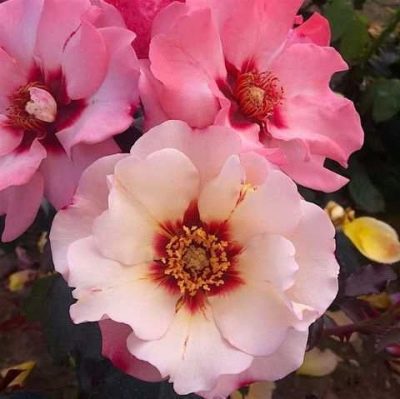
- Authors: Harkness
- Name synonyms: Alissar, Princess of Phenicia, Alissar Princess of Fonikia
- Breeding year: 2009
- Group: bush
- The main color of the flower: pink
- Flower size: large
- Diameter, cm: 7-10
- Flower type by number of petals: semi-double
- Scent: pleasant
- Description of the bush: branched
Rose variety Alissar Princess of Phoenician was bred in the UK as a result of selection in 2009. He also has the names Alissar, Princess of Phenicia, Alissar Princesses of Fonikia.
Description of the variety
Alissar Princess Phoenician belongs to the group of spray roses. The variety is used for cutting, as a standard form, for group planting, growing in flower beds, for planting in small groups, for borders.
The species is a branchy bush, its average height is 120 cm, and its width is 80 cm. The leaves on it are dark green, rather large.
The flowers are pink, their core is usually burgundy. They are quite large in size. Their average diameter is 7–10 cm. By the number of petals, the flower is semi-double.
3-5 buds are placed on one stem. They gather in low-flowered inflorescences. The buds have a pleasant aroma of medium intensity.
Advantages and disadvantages
Among the advantages of such a rose, one should highlight its high resistance to diseases and pests, increased frost resistance, and drought resistance. In addition, Alyssar the Phoenician Princess has a beautiful decorative appearance, she can decorate almost any landscape. Moreover, it does not fade in the sun at all. It has no significant drawbacks.
Flowering features
This rose blooms profusely throughout the summer. The plant is re-flowering.
Landing
This rose should be planted in late April - early May. But you can do this in the fall from mid-September to mid-October. Planting holes should be prepared in advance. Their width and depth should be at least 50 cm. Fertilizers are preliminarily applied to each pit.
Growing and care
It is best to grow such a rose in well-lit areas. It is absolutely not demanding on the soil. In the process of development, the plant will need regular watering. Cold water should not be used for these procedures.
In addition, it is necessary to carry out periodic pruning. Faded inflorescences should be cut off. Also, in the process of growth, it will be necessary to make nutritious dressings, it is better to use complex formulations.
After flowering, the shoots must be removed. This procedure allows you to stimulate the active growth of new buds.
Diseases and pests
This variety is considered to be very resistant to diseases and various pests. It is extremely rare for a flower to suffer from powdery mildew. In this case, shoots, buds and foliage will be covered with a whitish bloom. Gradually, the leaf blades begin to curl and fall off.
Sometimes garden roses of this variety are also affected by black spot. In this case, blurry black spots are formed on the plant. The lower leaves may turn yellow. To cure the flower, first cut off all the damaged parts, and then carry out the treatment with Bordeaux liquid or ready-made fungicides ("Topaz", "Bactofit", "Skor"). To completely cure the plant, several treatments are carried out.
Also, pests may appear on a garden rose, including spider mites, aphids, rose leafworm, pink scale insect, thrips. Various insecticides should be used to kill all parasites. The preparations "Biotlin", "Commander Maxi" will be suitable.If the plant has a small number of insects, it is permissible to use a simple soap solution.
Review overview
Many gardeners spoke positively about roses of this variety. People say that roses are beautiful and delicate. The flower is ideal for decorating the site. In addition, some have noticed that Alyssar Princess of Phoenician is absolutely unpretentious in her care. It will require minimal care.
According to gardeners, this rose has a delicate pleasant scent. The high resistance to diseases and parasites has also earned positive reviews.































































